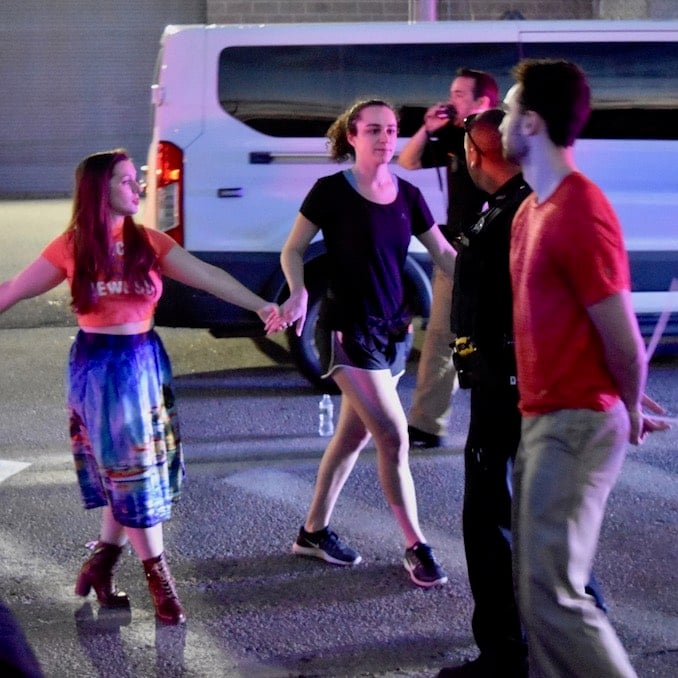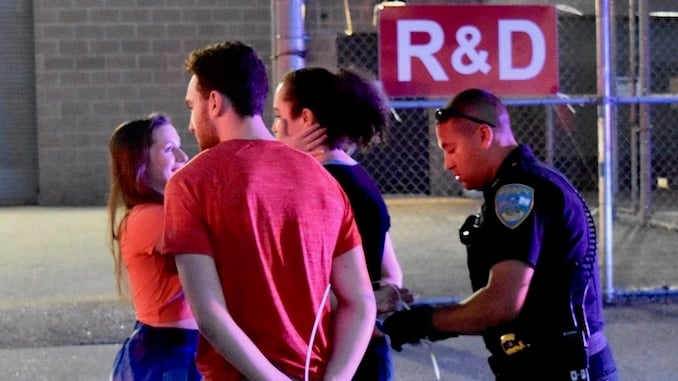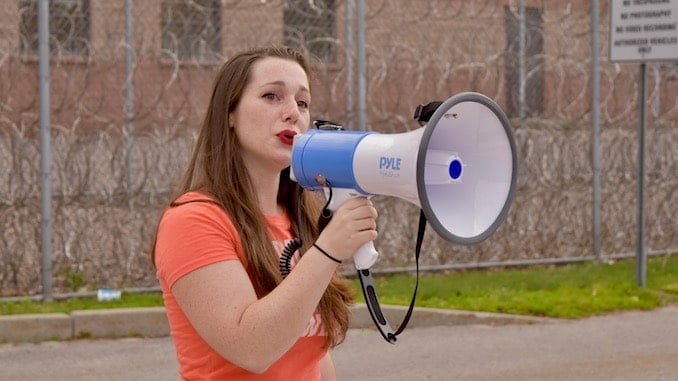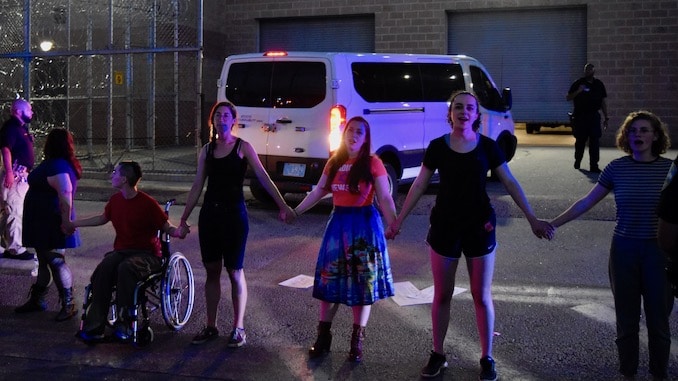Katherine Bogen: Buddies in Resistance – Building Intentional Activist Partnerships
I meet Maya, a woman I have already come to love, at a civil disobedience training. Tonight, there is a rally to protest collaboration between ICE and a law enforcement agents at a local detention facility, which has been targeting and holding migrants from our communities. Maya and I are both at this training to learn the process of direct,
July 3, 2019, 10:30 pm
By Katherine W Bogen
I meet Maya, a woman I have already come to love, at a civil disobedience training. Tonight, there is a rally to protest collaboration between ICE and a law enforcement agents at a local detention facility, which has been targeting and holding migrants from our communities. Maya and I are both at this training to learn the process of direct, non-violent action, and happen to choose seats next to one another. Maya compliments one of my protest signs (“Cute Jewess Against Ugly Policy”), I offer to share one with her (“Never Again Para Nadie”), and we discuss the activist journeys that brought us into this room. Both young Jewesses – bright-eyed and bushy-tailed, eager to take on institutions that perpetrate harm – both a little bit nervous, both risking arrest for the first time, we laugh about our shared neuroses (anxiety runs in our blood! Must have something to do with all of that intergenerational trauma. Our families were murdered. We’re a twitchy people. Ha ha.) and chat about the importance of “carbing up” before a big rally. She offers to share her chicken sandwich, and reminds me to drink enough water.

When the protest organizer encourages each member of our group to find a protest “buddy” – someone to check in with during this direct action – Maya is the obvious choice. Already, we have developed a bond of solidarity. Already, I am warmed by the fact that I will not have to go through this evening alone. It is a comfort to know that someone else present will intentionally have my back. It gives me a sense of responsibility, camaraderie, and fellowship to know that I am also contracted to their safety and emotional wellbeing. We have known each other for 10 minutes, and yet, we are a team.
The protest organizer instructs each pair of protest “buddies” to share our goals and our needs with one another. “My love language is touch,” Maya tells me. “So, I may need you to hold my hand or rub my back. It helps me feel grounded.” I smile, and nod, and my shoulders gain a little distance from my ears as my anxiety calms. “I am also deeply affectionate, so hugs are great. Bring them on!” I tell her. She warns me that she’s an easy crier, and gives me permission to ignore it. I share my fear about how this protest experience may impact my upcoming graduate school applications.
“I’m applying to PhD programs in the fall, and am nervous that being arrested tonight will require me to check that box – you know, the one about your record?” Maya asks me what I’m going to need from her in order to stay present and focused. “Remind me that this is worth it,” I say. “Remind me that this is a low price to pay compared to the suffering of refugees, asylum seekers, immigrants, and any non-white person who interacts with law enforcement.” Maya puts a hand on my shoulder, and smiles at me. Her eyes are warm and wide and brown. “This will be worth it,” she says. I believe her.
Throughout the night of direct action, Maya and I remain at each other’s sides. We offer to hold the protest banner behind the speakers during the formal rally events. We catch each other’s eyes and smile when our community members, fellow activists, and leaders make particularly moving and compelling points. We tear up at the same moments. Periodically, I touch Maya’s shoulder or her back. When the direct action begins, we move to block the entrance to the detention center together. We stand beside each other and hold hands, each of our palms sweaty. When police walk by, zip-ties in hand, walkie-talkies buzzing, we link our fingers. When we hear that state police have arrived, and are discussing a plan to arrest protesters on the other side of the building, we squeeze each other’s hands. Over the course of the evening, we hug many times. Maya teaches me the Hebrew lyrics to a song I haven’t heard. She encourages me to lead the protest group in a rendition of John Lennon’s “Imagine” and compliments my singing voice. We pray together. We dance in our barricade line. She talks to me about her rabbi and her community.
Our mutual support is unwavering. At the end of the night, when state and local police begin arresting protesters, we link arms in front of the detention center gate, to block a van from coming through. We follow along with the protest organizers, who are leading chants and raising impassioned voices in song. We watch together, trembling a bit with adrenaline, as our fellow protesters’ hands are zip-tied. When Maya is arrested, I stand in front of her and do not break eye contact. I put my hands on her shoulders, and then on either side of her face. I tell her it will be okay, even though I’m not sure, even though I’ve never done this before. She looks at me, hard, and says, “this is worth it.” Graduate school is far from my mind, but Maya’s commitment to addressing my anxieties, even while she is in the process of being arrested herself, is a stark reminder of what selflessness and solidarity look like. I watch police walk Maya away, and offer my wrists when an officer approaches me. I am put in the back of a squad car.

At the police station, we are processed separately. Maya and I are herded into separate holding cells, but I see her outside of the window when she is walked into the room next to mine. We wave at each other. Any time we catch glimpses of each other throughout the night, we smile, say hi, check in, promise to “see you later!” I make it home by 1 AM, and promptly fall asleep.
The next morning, I receive a Facebook message from Maya when I’m at work – “Hey!! How are you feeling?? Thank you for being the best protest buddy ever <3 <3” We unpack our experiences from the night before and share some worries about how our workplaces will react to our civil disobedience. Even after the protest has officially ended, Maya is still checking up on me.
Before the Wyatt Detention Center protest, I had never considered the importance of having a protest buddy. Though I’ve attended protests with friends to help ensure physical safety, I’ve hardly considered the importance of buddy-system fellowship to maintain emotional wellbeing during civil disobedience. When I’ve previously attended rallies and protest, I’ve struggled with a sense of isolation and anxiety. I’ve been plagued with questions like – am I doing this for the right reasons? What is going to happen next? Who do I turn to if things “get ugly”? Am I making a difference? Is this worth the risk?
Having a protest buddy is an antidote to isolation during direct action. It concretely proves the importance of building solidarity among people in the movement, as well as the positive psychosocial impacts of intentionally counteracting protester isolation. The “buddy” system also incorporates humanity and fellowship into activism, which helps prevent the “narcissist/savior” phenomenon. No longer are we engaging in direct action for others. Rather, we are engaging in direct action with others, as a method of collective empowerment and development of community agency. One of my favorite guides for social justice ally identity development, conceptualized by Keith E. Edwards (2006), highlights the importance of “combined selfishness” (i.e. I do this for us) and “spiritual or moral foundation” (i.e. I seek to connect and liberate us all on spiritual and moral grounds). Having Maya as my buddy brought these foci into stark reality. Rather than being a solitary voice, I was one member of a partnership, made stronger by the presence and sincerity of a woman I had only just met.
I enthusiastically encourage community organizers, activists, allies, and anyone engaging in civil disobedience or direct action to embrace the buddy system. Share your needs and goals with another person who promises to stick by your side throughout the action. Make sure you’re aware of each other’s “love language,” and be authentic and straightforward regarding your anxieties. Tell each other to drink more water. Squeeze each other’s hands. Check in. This human connection will not only sustain us in the moments when we are fighting state-sponsored abuses and injustice – it has the capacity to sustain our entire movement, as we build networks and friendships that provide much-needed revolutionary energy. As we connect to human beings who share our values and validate our concerns. I am confident that I have found a lifelong friend in Maya, and I met her less than 24 hours ago. THIS is how we build resistance – by being soft with one another, and taking our faces in each other’s hands, and reminding each other, every day: “this is worth it.”
Acknowledged Contributor: Maya Dayan
Note from the author: When I sent this article to Maya for her approval and review, this was the message I received, “I’m tearing up at work! I’m so honored to have shared this with you, and that you felt this connection as strongly as I did…What a blessing to be disorderly with you. That moment in cuffs meant everything.” Simply the fact that the same experiences from our night resonated so strongly for the two of us is a true indication that beautiful bonds and authentic connection can be built in an instant, during moments of struggle. I hope all of my comrades had similar experiences of spiritual solidarity with their protest buddies last night.







